Articles
- Page Path
- HOME > J Korean Powder Metall Inst > Volume 27(6); 2020 > Article
-
ARTICLE
- Effect of 50 μm class granules on the Injection Behavior of Brushite Bone Cement Prepared via Pre-dissolution Route
- Da Hye Muna, Sang Cheon Leeb, Kyung-Sik Oha,*
-
Journal of Korean Powder Metallurgy Institute 2020;27(6):468-476.
DOI: https://doi.org/10.4150/KPMI.2020.27.6.468
Published online: November 30, 2020
a School of Advanced Materials Engineering, The Center of Biomedical Materials and Biotechnology, Andong National University, 1375 Gyeongdong-ro Andong, 36729, Republic of Korea
b Department of Maxillofacial Biomedical Engineering and Institute of Oral Biology, School of Dentistry, Kyung Hee University, Seoul 02447, Republic of Korea
- *Corresponding Author: Corresponding Author: Kyung-Sik Oh, TEL: +82-54-820-5783, FAX: +82-54-820-6211, E-mail: ksoh@andong.ac.kr
- - 문다혜: 학생, 이상천·오경식: 교수
• Received: November 27, 2020 • Revised: December 21, 2020 • Accepted: December 23, 2020
© The Korean Powder Metallurgy Institute. All rights reserved.
- 736 Views
- 1 Download
Abstract
- The bone cement used for vertebroplasty must be sufficiently injectable. The introduction of granules reduces the amount of liquid required for liquefaction, implying that higher fluidity is achieved with the same amount of liquid. By employing β-tricalcium phosphate granules with an average diameter of 50 μm, changes in injectability are observed based on the paste preparation route and granular fraction. To obtain acceptable injectability, phase separation must be suppressed during injection, and sufficient capillary pressure to combine powder and liquid must work evenly throughout the paste. To achieve this, the granules should be evenly distributed. Reduced injection rates are observed for dry mixing and excessive granular content, owing to phase separation. All these correspond to conditions under which the clustered granules weakened the capillary pressure. The injected ratio of the paste formed by wet mixing displayed an inverted U-type shift with the granular fraction. The mixture of granules and powder resulted in an increase in the solid volume fraction, and a decrease in the liquid limit. This resulted in the enhancement of the liquidity, owing to the added liquid. It is inferred that the addition of granules improves the injectability, provided that the capillary pressure in the paste is maintained.
- Vertebroplasty is a minimally invasive surgical operation that reinforces the vertebral region by injecting setting liquid through cannula with the aim of alleviating pain caused by spinal compression [1]. The setting liquid is usually called a bone cement, and is a mixture of powder and liquid. Among the various types of bone cement, calcium phosphate bone cement has drawn much attention as an injectable setting material, due to its excellent biocompatibility [2]. Increasing the amount of liquid portion certainly improves injection behavior, but reduces the density and compressive strength of the set cement [3, 4], so is not suitable for the purpose of vertebroplasty. Thus, the granulation of the starting material has been attempted [5] as a way to improve the injection quality, without increasing the liquid volume. The brushite cement is composed of β-tricalcium phosphate (Ca3 (PO4)2: β-TCP) and monocalcium phosphate monohydrate (Ca(H2PO4)2H2O: MCPM) [6]. They react with deionized water to form dicalcium phosphate dihydrate (CaHPO42H2O: DCPD) as Eq. (1).
- The amount of liquid for liquefaction can be reduced by granulating β-TCP [7]. This means that the amount of liquid consumed for liquefaction will decrease, resulting in higher injection quality as the remaining liquid will contribute to improved liquidity [7]. Therefore, it is nec-essary to systematically approach the specific conditions of utilizing the granular β-TCP, such as the granular fraction, size of the granules, and route for preparation of the paste.
- In particular, attention needs to be paid to phase separation phenomena [8] in the injection of cement. This is also known as filter press [9], and is caused by the shear rate difference between liquid and powder during deformation by applying pressure to paste [9, 10]. Generally, the fluidity of the liquid is greater than that of the solid state powder; but in the paste, the liquid exists within the pore among the powders, and is affected by capillary phenomena. In other words, the liquid is bound to the solid powder by wetting, and moves with the powder. However, the capillary pressure is reciprocally proportional to the size of the pore, which is likely to be large near the granule, thus greatly reducing capillary pressure. If the granules are locally clustered in the paste, the ability to withhold liquid decreases due to a reduction in capillary pressure, meeting the conditions for phase separation.
- The phase separation results in the strong uneven distribution of liquid, which affects the properties of the set cement. Therefore, attention must be paid to the occurrence of phase separation, which not only reduces the injected amount, but also causes unexpected properties of the set cement. To achieve a uniform distribution of cement, it is necessary to pay attention to the experimental parameters, such as the granular fraction, and mixing route of paste. In this work, wet mixing was attempted for powder ingredients, instead of dry mixing in the previous work [7]. This is the route of dissolving the highly soluble MCPM first, and subsequently mixing with β- TCP. In particular, the MCPM is known to be endothermic [11], so heated liquid was used to increase the solubility. The injected ratio was observed with the granular fraction and heat treatment temperature of granules.
- The injected ratio was analyzed in relation to the plastic limit (Vpl). Vpl is the critical liquid amount required to liquefy the powder [12], and can be measured as reported [7]. Previous study [7] has shown that the introduction of 130 μm coarse granules has improved injection with a decrease in Vpl. However, it was necessary to investigate and understand the change in Vpl, so in this study, the cause of the change in Vpl was interpreted in relation to solid volume fraction, using 50 μm medium granules. From the analysis, the conditions for obtaining good injection quality without phase separation were discussed.
1. Introduction
- 2.1 Preparation of Granules
- The β-TCP granules (Sigma-Aldrich, Germany, 96%, average particle size of 1.9 μm) were prepared by spray drying [7], and subsequent sintering at 1050~1200°C for 2 h. Compared to the previous report [7], smaller granules were prepared by rapid spinning of atomizing disk at 15,000 rpm. The morphologies of the prepared granules were observed using scanning electron microscopy (SEM, Tescan VEGA II LMU). The average diameters of granules were measured microscopically from more than 20 granules at each condition.
- 2.2 Measurement of Vpl
- Mixture of the β-TCP powder and sintered granules was compacted by uniaxial pressing into discs at 10 MPa and subsequent cold isostatic press at 100 MPa for evaluation of the Vpl [7]. The prepared compact had a diameter of 1 cm and weighed 1 gram. The mixing ratios between the sintered granule and the powder ranged 5:5 to 7:3. The densities of the β-TCP compact ranged from 1.57 to 1.63 g/ml, regardless the sintered temperature and fraction of granules. We evaluated Vpl from the total volume of DI water supplied using a micropipette to the compact, until the beginning of flow.
- 2.3 Preparation of Paste
- The cement consisted of 0.6 g of β-TCP and 0.4 g of MCPM (Sigma-Aldrich, Japan, 95%). The β-TCP was a mixture of sintered granules and as-received powder with mixing ratios from 5:5 to 7:3. Three kinds of pastes were produced according to the mixing routes. The case of adding liquid after a dry mixing of β-TCP granules, β- TCP powder and MCPM together was referred to as conventional mixing (CM). The process of preliminary dissolving MCPM in a liquid and subsequent mixing it with both β-TCP granule and powder was called Pre-Mixing (PM). The route of dissolving the MCPM into water heated to 50°C and mixing it with β-TCP granules and powders was referred to as Heated Pre-Mixing (HPM). Aqueous dissociation of MCPM produces phosphoric acid, as shown in Eq. (2).
- 2.4 Evaluation of Injectability
- The prepared paste was loaded in the syringe of 13.65 mm diameter and 89.81 mm length, respectively. The paste was injected through a hole of 2 mm diameter. The specifications of the syringe were well consistent with those used in actual surgery [13]. Injection was carried out using a syringe pump (Nexus 3000, CHEMYX, Korea) at a rate of 10 ml/min under 400 Pa within 12 s. The injected ratios were obtained by dividing the injected weight by the loaded weight in the syringe [14]. The amount of water in the cement was measured from the weight change by drying at 150°C for 10 h for both injected cement from the syringe, and the cement remaining in the syringe.
2. Experimental
- Figure 1 shows the microstructure of granules obtained after 2 h of sintering at 1050, 1100, 1150, and 1200°C respectively. The granules were spherical, and had an average diameter of 50.2, 52.9, 57.3, and 53.3 μm, respectively, depending on the sintering temperature.
- Figure 2 is the measurement of the Vpl with the sintering temperature of granules. A comparison was made with the Vpls of coarse granules[7] with an average diameter of 130 μm. Hereafter, the granules prepared in this study were referred to as ‘medium’, while the granules reported in previous study[7] were referred to as ‘coarse’. The Vpls of medium granules as a result of sintering at 1050, 1100, 1150 and 1200°C were reduced to 0.660, 0.630, 0.620, and 0540 ml/g respectively. As Vpl is the amount of water that can wet all granules and is related to the surface area, the results of Fig. 2 can be considered to be a reduction in Vpl due to a reduction in the surface area of granules as a result of sintering. Also, for medium granules, the specific surface area should be larger than that of coarse granules, so the Vpl is considered to have larger value.
- Figure 3 is the measurements of Vpl in a mixture of medium granule and powder. The Vpl can be seen to change in U-shape as the granular fraction (xG) changes from 0.5 to 0.7. The minimum Vpl was 0.54 ml/g at the xG of 0.6, regardless of the sintering temperature. Compared at the same xG of 0.5 and 0.7, the mixing of granules sintered at 1100°C had a larger Vpl, which is believed to be due to the larger specific surface area of granules sintered at 1100°C.
- Figure 4 presents the injected ratio with the xG according to the sintering temperatures of A) 1050, B) 1100, C) 1150, and D) 1200°C. The injected ratio was obtained by dividing injected mass by loaded mass, and presented in percentage. The Fig. 4 shows noticeable difference in the injected ratio according to the preparation route of paste, while Table 1 shows the averages of injected ratio with the preparation routes and the xG. The injectability of the paste by HPM (83.8%) was superior to that of the PM route (79.3%) at all sintering temperatures, and the CM had the lowest injected ratio (73.4%). Figures 4 A) and B) show a sharp drop of the injected ratio at high xG. Pastes with granules sintered at 1050°C show a sharp drop at xG between 0.7 and 0.8, while for the pastes with the granule prepared at 1100°C, the drop is evident at 0.8. On the other hand, for the granules sintered at 1150 and 1200°C shown in Figs. 4 C) and D), no sharp drop in injected ratio, such as in A) and B), is evident.
- Figure 5 shows the observed injected ratio according to the xG for HPM paste. The inverse U-shaped change is shown in sintering at 1050, 1100, and 1150°C, and the maximum value is found at xG of between 0.6 and 0.7. This behavior is similar to that of the paste produced by the PM process. In the case of sintering at 1200°C, the injected ratio saturated near 90% at wide range of xG, and thus the inverse U-shape is not distinguished.
- Figure 6 shows the change of injected ratio with sintering temperature of granules at xG = 0.7 according to the preparation routes. As previously discussed, HPM pro-duced the best injected ratio, followed by PM and CM. In addition, when the sintering temperature was low, the difference of injected ratio between the preparation routes was large; but as the sintering temperature increased, the injected ratio increased, and the difference decreased.
- Figure 7 shows the injected paste which was prepared by the CM route using granules (xG = 0.8) sintered at 1100°C. The paste exhibited 53% of injected ratio and was accompanied by phase separation. Fig. 7 (A) shows the liquid-rich injected part, while Fig. 7 (B) shows that the paste remaining within the syringe was friable. The first discharged part was more watery than the subsequently discharged part. The phase separation was verified from the 64% of weight loss from the first discharged part, while the paste in the syringe lost only 37% as result of heating at 150°C.
- During the injection, the paste is deformed by pressure, and discharged into a narrow hole. The paste is a mixture of liquid and powder, and the content of liquid must be sufficient to be continuously connected while wetting the surface of all the powder before deformation takes place, to enable further discharge. Separation occurs when the externally applied strain rate is excessive, and only one of the liquids or powders (actually liquid) can follow the strain rate. The background of allowing liquids and powders to move together without the occurrence of phase separation lies in the coupling of liquids and powders by the surface tension between liquids and powders. The force combining liquid with powder is determined not only by surface tension, but also by the size of the voids present between the powders, which is called capillary pressure. This capillary pressure is inversely proportional to the size of the pore, so the liquid between fine powders is strongly bound to the powder by sufficient capillary pressure; however, the binding force decreases inversely to the size of the pore. Large granules, such as in this study, are likely to accompany large pores in the vicinity, which may reduce capillary pressure, and cause phase separation.
- The results from Fig. 4 and Table 1 show that CM has a low injected ratio, which is related to the occurrence of phase separation, as seen in Fig. 7. In the same xG, pastes by PM or especially HPM exhibited less phase separation, and had a higher injected ratio of more than 10%. In general, wet mixing is known to be more efficient than dry mixing [15] and is likely to have higher uniformity if the β-TCP granules and powder are mixed with a pre-dissolved liquid phase of MCPM. In particular, as MCPM is endothermic [11], its dissociation increases when the temperature of the solution is elevated. So the dissociation of MCPM in the heated solution is believed to contribute to achieving a more uniform state in the mixing process. Increased uniformity will less likely induce clustered granules, and will help prevent the phase separation.
- The results show that for dry mixing, as described above, the reduction of injected ratio was associated with the phase separation; and under the same conditions, the injected ratio was even reduced when the sintering temperature of granules was low. Previous study [7] have shown that open pores in granules were eliminated by the sintering at 1200°C and that the lower the sintering temperature, the more open pores were present. These open pores absorb the liquid into the granules and reduce the amount of liquid for liquidity of paste. As a result, the granules sintered at low temperature adversely affect the injection properties. In addition, the xG is also a variable that affects phase separation. The greater the xG, the greater the probability of the clustered granules, and the lower the capillary pressure, increasing the likelihood of phase separation. These results mean that the appropriate conditions for implementing improved injection behavior for 50 μm class granules are 1) uniformity through wet mixing, 2) open pore free granules, and 3) moderate xG.
- Figure 5 showed the inverted U-shaped injected ratio that was observed with xG in the case of paste prepared by the HPM route. In the same xG segment, Vpl was Ushaped, such as in Fig. 3, and that was opposite to the injected ratio. This inverse relationship between Vpl and injected ratio has been also confirmed in previous report [7]. Vpl is the volume fraction of pore among the total volume of powder and pore, as shown in Fig 8, while the solid volume fraction is the fraction of the volume of the powder among the total volume. In the literature [16], this was abbreviated as SVF. Thus the Vpl and SVF are complementary with each other, as shown in Eq. (3) and share the same physical unit (ml/g).
- Vpl is measured from the cumulative volume of liquid by repeatedly adding a small amount of liquid to the green body [7, 12]. Thus Vpl is the minimum amount of liquid needed to secure liquefaction, so the remaining extra liquid of the liquid added for paste preparation will be used to improve liquidity. The smaller the Vpl, the more the liquid will contribute to the increase in liquidity.
- Figure 9 shows a schematic illustration of the filled state with A) coarse granule only, and B) fine particle only, where the SVFs are the same, regardless of particle size [17]. However, a mixture of coarse granule and fine particles, such as C), allows fine particles to fill the space near the coarse granules, resulting in a larger SVF. As a result, the SVF is larger in C) than in A) or B). If the coarse granule fraction is expressed in horizontal axis, the SVF will have an inverted U-shape. Hence, the Vpl of C) is smaller than those of A) and B) according to the relation of Eq. (3). Thus, as in this study, if paste is prepared with the same of amount of 0.8 ml/g, C) consumes less liquid for liquefaction, and the rest of the liquid is used to increase fluidity.
- Thus, mixing granules and powder at an appropriate ratio can increase the SVF and lower the Vpl, which means that higher liquidity can be obtained from the same liquid volume. SVFs resulting from the mixture of granules and powders show an inverted U-shape with xG, which means that Vpl, which is a complementary relationship with SVF, becomes U-shape. Thus, the smaller the Vpl, the higher the liquidity, so the injection characteristics appear to be inverted U-shape, such as in Fig. 5.
- These conditions are meaningful when granules are uniformly mixed with powder, and appear to be more clearly observed for paste prepared with PM or HPM. Therefore, the PM or HPM process that promotes efficient mixing is considered to have practical advantages, as well.
3. Results and Discussion
Fig. 1
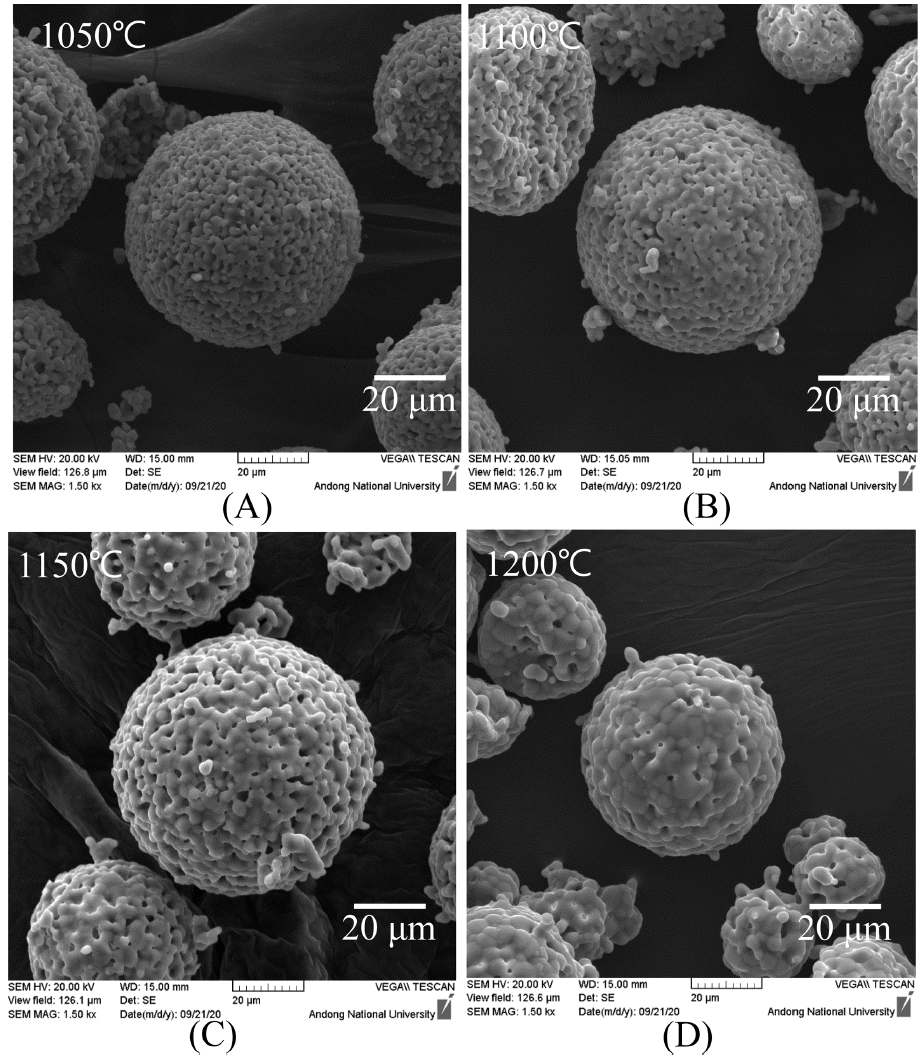
β-TCP granules prepared via spray-drying and subsequent sintering at (A) 1050°C, (B) 1100°C, (C) 1150°C, and (D) 1200°C for 2 h.

Fig. 2
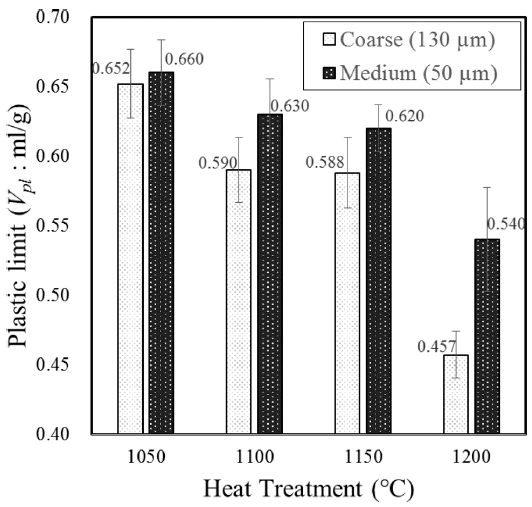
Plastic limit of granular β-TCP compact with the sintering temperature of coarse β-TCP granules (average diameters with 130 μm) and medium β-TCP granules (average diameters with 50 μm), respectively.

Fig. 3
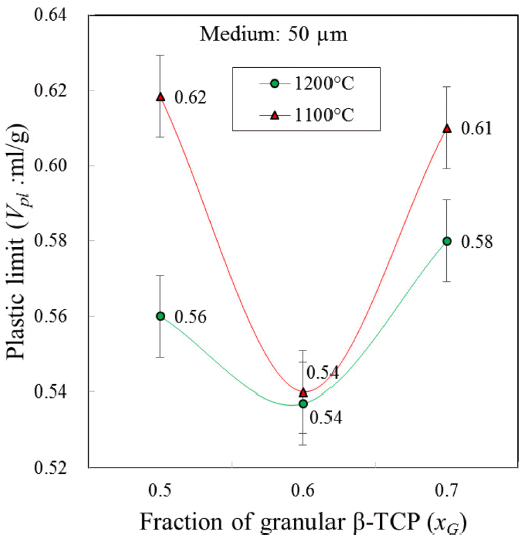
Plastic limits of compacts prepared with mixture of β- TCP powder and β-TCP granule. The β-TCP granules were sintered at either 1100°C or 1200°C for 2 h.

Fig. 4
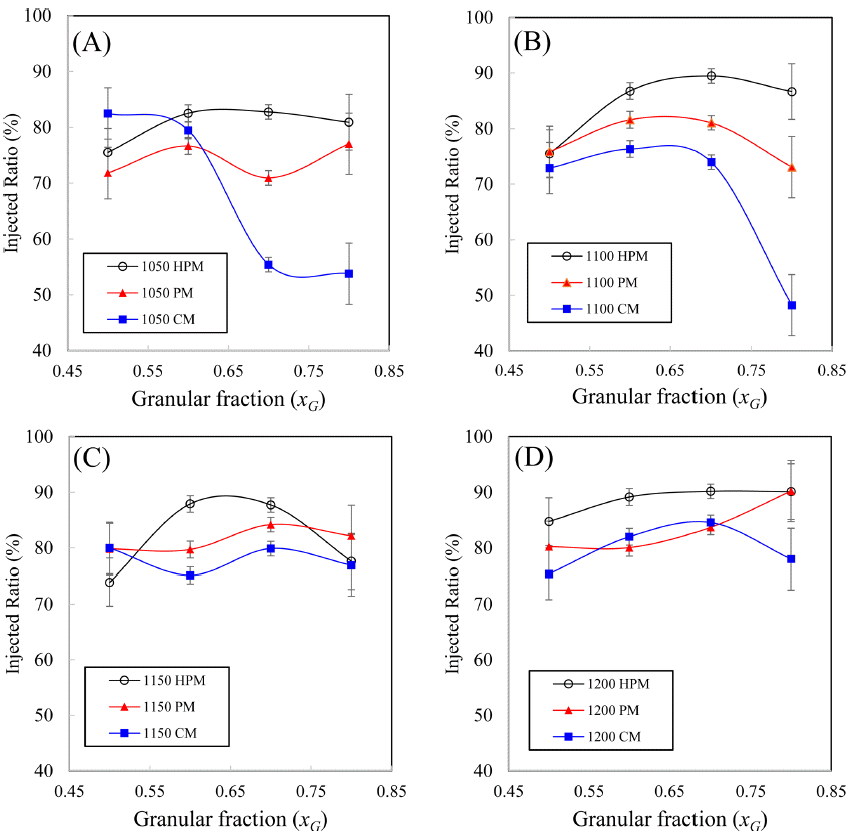
Injected ratio (%) of paste with the fraction of granular β-TCP in the paste. The granules were sintered at (A) 1050°C, (B) 1100°C, (C) 1150°C, and (D) 1200°C for 2 h.

Table 1
Average values of injected ratio with the preparation route of paste and granular fraction of β-TCP

|
Fig. 5
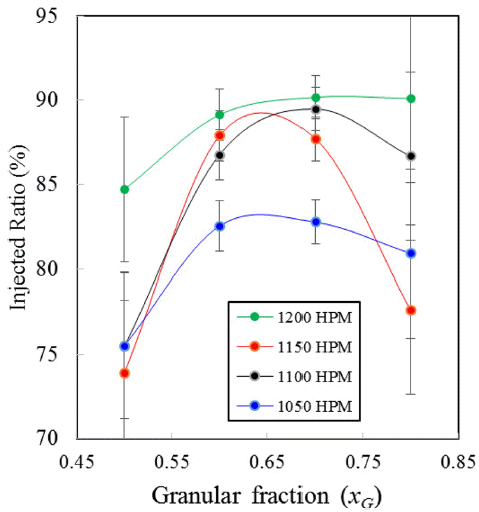
Injected ratio (%) of paste with the fraction of granular β-TCP in the paste. The granules sintered at 1050°C, 1100°C, 1150°C, and 1200°C for 2 h were prepared into pastes via the HPM route.

Fig. 6
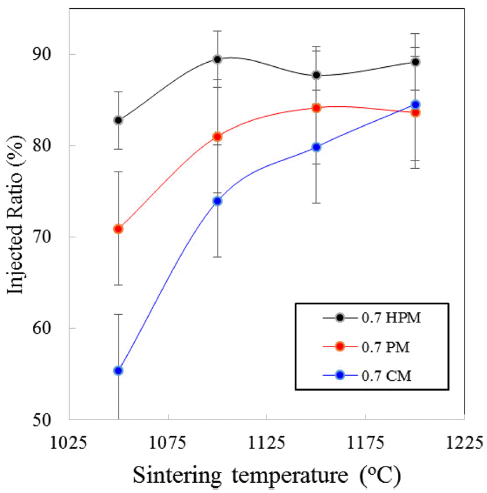
Injected ratio (%) of paste with the sintering temperature of granular β-TCP. The paste was prepared via HPM, PM or CM route for the granular fraction of 0.7.

Fig. 7

(A) Injected paste from the syringe, and (B) paste remaining within the syringe. The paste was conventionally mixed using the β-TCP granule prepared via spray-drying and subsequent sintering at 1100°C for 2 h with the granular fraction of 0.8.

Fig. 8
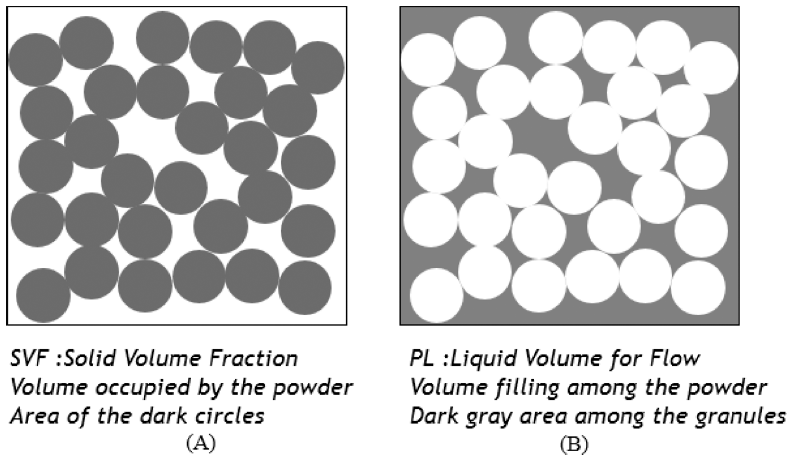
Schematic of the concept of (A) SVF, and (B) PL. Note that SVF and PL are in complementary relation to each other.

Fig. 9
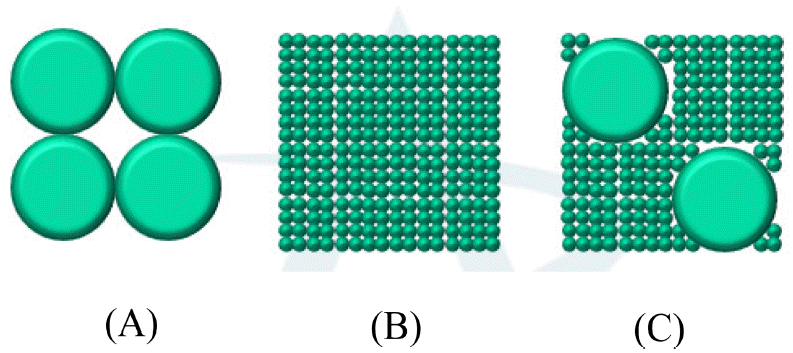
Schematic of the cement composed of (A) coarse granule only, (B) fine particle only, (C) mixture of coarse granules and fine particles.

- Brushite bone cement was produced using spherical β- TCP granules of diameter of 50.2 μm, which was prepared by spray drying and subsequent sintering. The paste was produced by mixing of powder through either the conventional dry route (CM) or wet mixing route (PM/HPM), and the injected ratio was observed with xG as a variable. The injected ratio decreased for CM at high xG accompanied by phase separation, which is likely to take place under the reduced capillary pressure. The paste produced by the HPM route showed the inverted Ushaped change in the xG tested, which was interpreted from the fact that Vpl had a U-shaped change in the same xG. A small Vpl means that extra liquid is provided to increase the injected ratio. The change in Vpl was attributed to an increase in SVF as a result of mixture between granule and powder. Thus, the addition of granules was beneficial for improved injectability, provided that weakening of the capillary pressure in the paste was controlled.
4. Conclusions
-
Acknowledgements
- This work was supported by a grant from 2019 Research Funds of Andong National University.
Acknowledgement
- 1. S. M. Belkoff, J. M. Mathis and L. E. Jasper: Am. J. Neuroradiol., 23 (2002) 1647. .
- 2. F. Theiss, D. Apelt, B. Brand, A. Kutter, K. Zlinksky, M.Bohner, S. Matter, C. Frei, J. A. Auer and B. von Rechenber: Biomaterials, 26 (2005) 4383. .ArticlePubMed
- 3. F. Tancret, J. M. Bouler, J. Chamousset and L. M. Minois: J. Eur. Ceram. Soc., 26 (2006) 3647. .Article
- 4. F. Pecqueux, F. Tancret, N. Payraudeau and J. M. Bouler: J. Eur. Ceram. Soc., 30 (2010) 819. .Article
- 5. K. S. Oh, S. R. Kim and P. Boch: Key Eng. Mat., 254- 256 (2004) 237. .Article
- 6. A. A. Mirtchi, J. Lemaitre and N. Terao: Biomaterials, 10 (1989) 475. .Article
- 7. H. H. Jo and K. S. Oh: J. Kor. Ceram. Soc., 55 (2018) 590. .Article
- 8. M. Bohner and G. Baroud: Biomaterials, 26 (2005) 1553. 5.ArticlePubMed
- 9. M. Habib, G. Baroud, F. Gitzhofer and M. Bohner: Acta Biomater., 6 (2010) 250. .ArticlePubMed
- 10. S. L. Rough, D. I. Wilson and J. Bridgwater: Chem. Eng. Res. Des., 80 (2002) 701. .Article
- 11. M. Bohner and U. Gbureck: J Biomed. Mater. Res. Part B Appl. Biomater., 84 (2008) 375. .ArticlePubMed
- 12. H. Andrianjatovo, F. Jose and J. Lemaitre: J. Mater. Sci.: Mater. Med., 7 (1996) 34. .Article
- 13. A. Ortiz: Appl. Radiol., 37 (2008) 10. .Article
- 14. J. Zhang, W. Liu, V. Schnitzler, F. Tancret and J. M. Bouler: Acta Biomater., 10 (2014) 1035. .ArticlePubMed
- 15. J. S. Reed: Principles of Ceramics Processing, 2nd edn, John Wiley & Sons, (1995) 338. .
- 16. C. C. Furnas: Ind. Eng. Chem., 23 (1931) 1052. .Article
- 17. X. Chateau: 6 – Particle packing and the rheology of concrete, in: N. Roussel (Ed.), Understanding the Rheology of Concrete, Woodhead Publishing, (2012) 117. .Article
Figure & Data
References
Citations
Citations to this article as recorded by 

Effect of 50 μm class granules on the Injection Behavior of Brushite Bone Cement Prepared via Pre-dissolution Route









Fig. 1
β-TCP granules prepared via spray-drying and subsequent sintering at (A) 1050°C, (B) 1100°C, (C) 1150°C, and (D) 1200°C for 2 h.
Fig. 2
Plastic limit of granular β-TCP compact with the sintering temperature of coarse β-TCP granules (average diameters with 130 μm) and medium β-TCP granules (average diameters with 50 μm), respectively.
Fig. 3
Plastic limits of compacts prepared with mixture of β- TCP powder and β-TCP granule. The β-TCP granules were sintered at either 1100°C or 1200°C for 2 h.
Fig. 4
Injected ratio (%) of paste with the fraction of granular β-TCP in the paste. The granules were sintered at (A) 1050°C, (B) 1100°C, (C) 1150°C, and (D) 1200°C for 2 h.
Fig. 5
Injected ratio (%) of paste with the fraction of granular β-TCP in the paste. The granules sintered at 1050°C, 1100°C, 1150°C, and 1200°C for 2 h were prepared into pastes via the HPM route.
Fig. 6
Injected ratio (%) of paste with the sintering temperature of granular β-TCP. The paste was prepared via HPM, PM or CM route for the granular fraction of 0.7.
Fig. 7
(A) Injected paste from the syringe, and (B) paste remaining within the syringe. The paste was conventionally mixed using the β-TCP granule prepared via spray-drying and subsequent sintering at 1100°C for 2 h with the granular fraction of 0.8.
Fig. 8
Schematic of the concept of (A) SVF, and (B) PL. Note that SVF and PL are in complementary relation to each other.
Fig. 9
Schematic of the cement composed of (A) coarse granule only, (B) fine particle only, (C) mixture of coarse granules and fine particles.
Fig. 1
Fig. 2
Fig. 3
Fig. 4
Fig. 5
Fig. 6
Fig. 7
Fig. 8
Fig. 9
Effect of 50 μm class granules on the Injection Behavior of Brushite Bone Cement Prepared via Pre-dissolution Route
Table 1
Average values of injected ratio with the preparation route of paste and granular fraction of β-TCP
Table 1
TOP
 KPMI
KPMI

 Cite this Article
Cite this Article









